Combining Multiple Geospatial Data for Estimating Aboveground Biomass in North Carolina Forests
Abstract
:1. Introduction
2. Data and Study Area
- (a)
- The NLCD for the year 2011 was downloaded from the MLRC, 2021 [27]. While the 2016 version of the NLCD is the latest available, it is outside of the range covered by the latest FIA data available for the state;
- (b)
- CDL for the year 2011 was downloaded from the USDA, 2021 [26]. We chose the 2011 CDL data to allow for the comparison of CDL and the NLCD in the same year;
- (c)
- LiDAR data for the year 2013 was downloaded from the North Carolina Geospatial website (https://sdd.nc.gov/, accessed on 1 June 1 2021);
- (d)
- FIA for 2009–2013 were downloaded from (https://apps.fs.usda.gov/fia/datamart/CSV/datamart_csv.html, accessed on 1 June 2021). The data comes from the latest completed North Carolina FIA inventory cycle.
3. Methods
3.1. Land Cover Analysis
3.2. Tree Heights and LiDAR Analysis
3.3. Tree Diameters and AGFB Estimation
4. Results
4.1. Comparison of CDL and NLCD
4.2. Tree Heights and LiDAR Analysis
4.3. Tree Diameters and AGFB Estimation
5. Discussion
6. Conclusions
Author Contributions
Funding
Institutional Review Board Statement
Informed Consent Statement
Conflicts of Interest
References
- Cartisano, R.; Mattioli, W.; Corona, P.; Mugnozza, G.; Sabatti, M.; Ferrari, B.; Cimini, D.; Giuliarelli, D. Assessing and mapping biomass potential productivity from poplar-dominated riparian forests: A case study. Biomass Bioenergy 2013, 54, 293–302. [Google Scholar] [CrossRef] [Green Version]
- Matasci, G.; Hermosilla, T.; Wulder, M.; White, J.; Coops, N.; Hobart, G.; Zald, H. Large-area mapping of Canadian boreal forest cover, height, biomass and other structural attributes using Landsat composites and lidar plots. Remote Sens. Environ. 2018, 209, 90–106. [Google Scholar] [CrossRef]
- U.S. Department of Energy (USDOE). 2016 Billion-Ton Report: Advancing Domestic Resources for a Thriving Bioeconomy, Volume 1: Economic Availability of Feedstocks; Langholtz, M.H., Stokes, N.J., Eaton, L.M., Eds.; ORNL/TM-2016/160; Oak Ridge National Laboratory: Oak Ridge, TN, USA, 2016; 448p. Available online: http://energy.gov/eere/bioenergy/2016-billion-ton-report (accessed on 7 July 2021). [CrossRef] [Green Version]
- Zhao, F.; Huang, C.; Goward, S.; Schleeweis, K.; Rishmawi, K.; Lindsey, M.; Denning, E. Development of Landsat-based annual US forest disturbance history maps (1986–2010) in support of the North American Carbon Program (NACP). Remote Sens. Environ. 2018, 209, 312–326. [Google Scholar] [CrossRef]
- Conrad, J.L., IV; Bolding, M.C.; Smith, R.L.; Aust, W.M. Wood-energy market impact on competition, procurement practices, and profitability of landowners and forest products industry in the U.S. south. Biomass Bioenergy 2011, 35, 280–287. [Google Scholar] [CrossRef]
- Abt, K.L.; Abt, R.C.; Galik, C.S.; Skog, K.E. Effect of Policies on Pellet Production and Forests in the U.S. South: A Technical Document Supporting the Forest Service Update of the 2010 RPA Assessment; General Technical Report SRS-202; U.S. Department of Agriculture, Southern Research Station: Ashville, NC, USA, 2014. [Google Scholar]
- Henderson, J.E.; Joshi, O.; Parajuli, R.; Hubbard, W. A regional assessment of wood resource sustainability and potential economic impact of the wood pellet market in the U.S. South. Biomass Bioenergy 2017, 105, 421–427. [Google Scholar] [CrossRef]
- Duden, A.S.; Verweij, P.A.; Junginger, H.M.; Abt, R.C.; Henderson, J.D.; Dale, V.H.; Kline, K.L.; Karssenberg, D.; Verstegen, J.A.; Faaij, A.P.C.; et al. Modeling the impacts of wood pellet demand on forest dynamics in southeastern United States: Modelling the impacts of wood pellet demand on forest dynamics in southeastern United States. Biofuels Bioprod. Biorefining 2017, 11, 1007–1029. [Google Scholar] [CrossRef] [Green Version]
- Abt, R.C.; Abt, K.L.; Cubbage, F.W.; Henderson, J.D. Effect of policy-based bioenergy demand on southern timber markets: A case study of North Carolina. Biomass Bioenergy 2010, 34, 1679–1686. [Google Scholar] [CrossRef]
- Prestemon, J.P.; Wear, D.N. Linking Harvest Choices to Timber Supply. Forest Sci. 2000, 46, 377–389. [Google Scholar]
- Caspersen, J.P.; Pacala, S.W.; Jenkins, J.C.; Hurtt, G.C.; Moorcroft, P.R.; Birdsey, R.A. Contributions of Land-Use History to Carbon Accumulation in U.S. Forests. Science 2000, 290, 1148–1151. [Google Scholar] [CrossRef]
- Galik, C.S.; Abt, B.; Wu, Y. Forest Biomass Supply in the Southeastern United States—Implications for Industrial Roundwood and Bioenergy Production. J. For. 2009, 107, 69–77. [Google Scholar]
- Polyakov, M.; Wear, D.N.; Huggett, R.N. Harvest Choice and Timber Supply Models for Forest Forecasting. Forest Sci. 2010, 56, 344–355. [Google Scholar]
- Brown, M.J.; Vogt, J.T. North Carolina’s Forests, 2013; Resource Bulletin SRS-2015; U.S. Department of Agriculture, Southern Research Station: Ashville, NC, USA, 2015. [Google Scholar]
- Burrill, E.A.; Wilson, A.M.; Turner, J.A.; Pugh, S.A.; Menlove, J.; Christiansen, G.; Conkling, B.L.; David, W. The Forest Inventory and Analysis Database: Database Description and User Guide Version 7.2 for Phase 2; U.S. Department of Agriculture, Forest Service: Washington, DC, USA, 2017; p. 946. Available online: http://www.fia.fs.fed.us/library/database-documentation/ (accessed on 7 July 2021).
- Lister, A.J.; Andersen, H.; Frescino, T.; Gatziolis, D.; Healey, S.; Heath, L.S.; Liknes, G.C.; McRoberts, R.; Moisen, G.G.; Nelson, M.; et al. Use of Remote Sensing Data to Improve the Efficiency of National Forest Inventories: A Case Study from the United States National Forest Inventory. Forests 2020, 11, 1364. [Google Scholar] [CrossRef]
- Liknes, G.C.; Nelson, M.D.; Gormanson, D.D.; Hansen, M. The Utility of the Cropland Data Layer for Forest Inventory and Analysis, Proceedings of the Eighth Annual Forest Inventory and Analysis Symposium, Monterey, CA, USA, 16–19 October 2006; McRoberts Ronald, E., Reams Gregory, A., Van Deusen Paul, C., McWilliams William, H., Eds.; Gen. Tech. Report WO-79; US Department of Agriculture, Forest Service: Washington, DC, USA, 2006; Volume 79, pp. 259–264. [Google Scholar]
- Chen, X.; Liu, S.; Zhu, Z.; Vogelmann, J.; Li, Z.; Ohlen, D. Estimating aboveground forest biomass carbon and fire consumption in the U.S. Utah High Plateaus using data from the Forest Inventory and Analysis Program, Landsat, and LANDFIRE. Ecol. Indic. 2011, 11, 140–148. [Google Scholar] [CrossRef]
- Ahamed, T.; Tian, L.; Zhang, Y.; Ting, K.C. A review of remote sensing methods for biomass feedstock production. Biomass Bioenergy 2011, 35, 2455–2469. [Google Scholar] [CrossRef]
- Rosette, J.; Suarez, J.; Nelson, R.; Los, S.; Cook, B.; North, P. LiDAR Remote Sensing for Biomass Assessment. Remote Sens. Biomass 2012, 3–21. [Google Scholar] [CrossRef] [Green Version]
- Zhen, Z.; Quackenbush, L.J.; Zhang, L. Trends in automatic individual tree crown detection and delineation—Evolution of LiDAR data. Remote Sens. 2016, 8, 333. [Google Scholar] [CrossRef] [Green Version]
- Lu, D.; Chen, Q.; Wang, G.; Liu, L.; Li, G.; Moran, E. A survey of remote sensing-based aboveground biomass estimation methods in forest ecosystems. Int. J. Digit. Earth 2016, 9, 63–105. [Google Scholar] [CrossRef]
- McRoberts, R.E.; Næsset, E.; Gobakken, T. Inference for LiDAR-assisted estimation of forest growing stock volume. Remote Sens. Environ. 2013, 128, 268–275. [Google Scholar] [CrossRef]
- Nelson, R.; Margolis, H.; Montesano, P.; Sun, G.; Cook, B.; Corp, L.; Andersen, H.-E.; DeJong, B.; Pellat, F.P.; Fickel, T.; et al. LiDAR-based estimates of aboveground biomass in the continental US and Mexico using ground, airborne, and satellite observations. Remote Sens. Environ. 2017, 188, 127–140. [Google Scholar] [CrossRef] [Green Version]
- McRoberts, R.E.; Liknes, G.C.; Domke, G.M. Using a remote sensing-based, percent tree cover map to enhance forest inventory estimation. Forest Ecol. Manag. 2014, 331, 12–18. [Google Scholar] [CrossRef]
- U.S. Department of Agriculture, National Agricultural Statistics Service (USDA/NASS). Cropland Data Layer; Published Crop-specific Data Layer; USDA-NASS: Washington, DC, USA, 2020. Available online: https://nassgeodata.gmu.edu/CropScape/ (accessed on 5 May 2018).
- Multi-Resolution Land Characteristics Consortium (MRLC). National Land Cover Database. 2020. Available online: https://www.mrlc.gov/data-services-page (accessed on 5 May 2018).
- Thomas, V.A.; Wynne, R.H.; Kauffman, J.; McCurdy, W.; Brooks, E.B.; Thomas, R.Q.; Rakestraw, J. Mapping thins to identify active forest management in southern pine plantations using Landsat time series stacks. Remote Sens. Environ. 2021, 252, 112127. [Google Scholar] [CrossRef]
- Kumar, L.; Mutanga, O. Remote sensing of above-ground biomass. Remote Sens. 2017, 9, 935. [Google Scholar] [CrossRef] [Green Version]
- Kumari, R.; Smith, A. Remote Sensing Based Forest Fragmentation Analysis Using GIS along Fringe Forests of Kollam District, Kerala. Int. J. Res. Appl. Sci. Eng. Technol. 2017, 728–739. [Google Scholar] [CrossRef]
- Zhang, C.; Zhou, Y.; Qiu, F. Individual tree segmentation from LiDAR point clouds for urban forest inventory. Remote Sens. 2015, 7, 7892–7913. [Google Scholar] [CrossRef] [Green Version]
- Wiggins, H.L.; Nelson, C.R.; Larson, A.J.; Safford, H.D. Using LiDAR to develop high-resolution reference models of forest structure and spatial pattern. Forest Ecol. Manag. 2019, 434, 318–330. [Google Scholar] [CrossRef]
- Liu, J.; Shen, J.; Zhao, R.; Xu, S. Extraction of individual tree crowns from airborne LiDAR data in human settlements. Math. Comput. Model. 2013, 58, 524–535. [Google Scholar] [CrossRef]
- García, M.; Riaño, D.; Chuvieco, E.; Danson, F.M. Estimating biomass carbon stocks for a Mediterranean forest in central Spain using LiDAR height and intensity data. Remote Sens. Environ. 2010, 114, 816–830. [Google Scholar] [CrossRef]
- Chen, W.; Xiang, H.; Moriya, K. Individual tree position extraction and structural parameter retrieval based on airborne LiDAR data: Performance evaluation and comparison of four algorithms. Remote Sens. 2020, 12, 571. [Google Scholar] [CrossRef] [Green Version]
- Yun, T.; Jiang, K.; Li, G.; Eichhorn, M.P.; Fan, J.; Liu, F.; Cao, L. Individual tree crown segmentation from airborne LiDAR data using a novel Gaussian filter and energy function minimization-based approach. Remote Sens. Environ. 2021, 256, 112307. [Google Scholar] [CrossRef]
- Chen, X.; Jiang, K.; Zhu, Y.; Wang, X.; Yun, T. Individual tree crown segmentation directly from UAV-borne LiDAR data using the PointNet of deep learning. Forests 2021, 12, 131. [Google Scholar] [CrossRef]
- Kwak, D.A.; Lee, W.K.; Lee, J.H.; Biging, G.S.; Gong, P. Detection of individual trees and estimation of tree height using LiDAR data. J. Forest Res. 2007, 12, 425–434. [Google Scholar] [CrossRef]
- Jimenez-Berni, J.A.; Deery, D.M.; Rozas-Larraondo, P.; Condon, A.T.G.; Rebetzke, G.J.; James, R.A.; Sirault, X.R. High throughput determination of plant height, ground cover, and above-ground biomass in wheat with LiDAR. Front. Plant Sci. 2019, 9, 237. [Google Scholar] [CrossRef] [Green Version]
- Yuancai, L. Remarks on Height-Diameter Modeling; US Department of Agriculture, Forest Service, Southern Research Station: Asheville, NC, USA, 2001. [Google Scholar]
- Niklas, K.J. Plant allometry: Is there a grand unifying theory? Biol. Rev. 2004, 79, 871–889. [Google Scholar] [CrossRef] [PubMed]
- Lhotka, J.M. Height-diameter relationships in Sweetgum (Liquidambar styraciflua)-dominated stands. South. J. Appl. For. 2012, 36, 98–106. [Google Scholar] [CrossRef]
- Saud, P.; Lynch, T.B.; KC, A.; Guldin, J.M. Using quadratic mean diameter and relative spacing index to enhance height–diameter and crown ratio models fitted to longitudinal data. Forestry 2016, 89, 215–229. [Google Scholar] [CrossRef] [Green Version]
- Bi, H.; Fox, J.C.; Li, Y.; Lei, Y.; Pang, Y. Evaluation of nonlinear equations for predicting diameter from tree height. Can. J. Forest Res. 2012, 42, 789–806. [Google Scholar] [CrossRef]
- Cao, Q.V.; Dean, T.J. Predicting diameter at breast height from total height and crown length. In Proceedings of the 15th Biennial Southern Silvicultural Research Conference; Guldin, J.M., Ed.; e-Gen. Tech. Rep. SRS-GTR-175; US Department of Agriculture, Forest Service, Southern Research Station: Asheville, NC, USA, 2013; Volume 175, pp. 201–205. [Google Scholar]
- Pascual, A. Using tree detection based on airborne laser scanning to improve forest inventory considering edge effects and the co-registration factor. Remote Sens. 2019, 11, 2675. [Google Scholar] [CrossRef] [Green Version]
- Holdt, B.; Civco, D.L.; Hurd, J. Forest fragmentation due to land parcelization and subdivision: A remote sensing and GIS analysis. In Proceedings of the 2004 ASPRS Annual Convention, Denver, CO, USA, 23–28 May 2004. [Google Scholar]
- Broadbent, E. Forest fragmentation and edge effects from deforestation and selective logging in the Brazilian Amazon. Biol. Conserv. 2008, 140, 142–155. [Google Scholar] [CrossRef]
- Ting, Z.; Shaolin, P. Spatial scale types and measurement of edge effects in ecology. Acta Ecol. Sin. 2008, 28, 3322–3333. [Google Scholar] [CrossRef]
- Holmes, J.S. Common Forest Trees of North Carolina (Revised), 12th ed.; North Carolina Department of Agriculture and Consumer Services, North Carolina Forest Service: Raleigh, NC, USA, 2012. [Google Scholar]
- Jenkins, J.C.; Chojnacky, D.C.; Heath, L.S.; Birdsey, R.A. National scale biomass estimators for United States tree species. Forest Sci. 2003, 49, 12–35. [Google Scholar]
- Henry, H.A.L.; Aarssen, L.W. The interpretation of stem diameter–height allometry in trees: Biomechanical constraints, neighbour effects, or biased regressions? Ecol. Lett. 1999, 2, 89–97. [Google Scholar] [CrossRef]
- Gonzalez-Benecke, C.A.; Gezan, S.A.; Martin, T.A.; Cropper, W.P., Jr.; Samuelson, L.J.; Leduc, D.J. Individual tree diameter, height, and volume functions for longleaf pine. Forest Sci. 2014, 60, 43–56. [Google Scholar] [CrossRef] [Green Version]
- Meng, Q.; Cieszewski, C.J.; Strub, M.R.; Borders, B.E. Spatial regression modeling of tree height–diameter relationships. Can. J. For. Res. 2009, 39, 2283–2293. [Google Scholar] [CrossRef]
- Jin, S.; Homer, C.; Yang, L.; Danielson, P.; Dewitz, J.; Li, C.; Zhu, Z.; Xian, G.; Howard, D. Overall methodology design for the United States national land cover database 2016 products. Remote Sens. 2019, 11, 2971. [Google Scholar] [CrossRef] [Green Version]
- What Is Lidar Data and Where Can I Download It? Available online: https://www.usgs.gov/faqs/what-lidar-data-and-where-can-i-download-it?qt-news_science_products=0#qt-news_science_products (accessed on 8 July 2021).
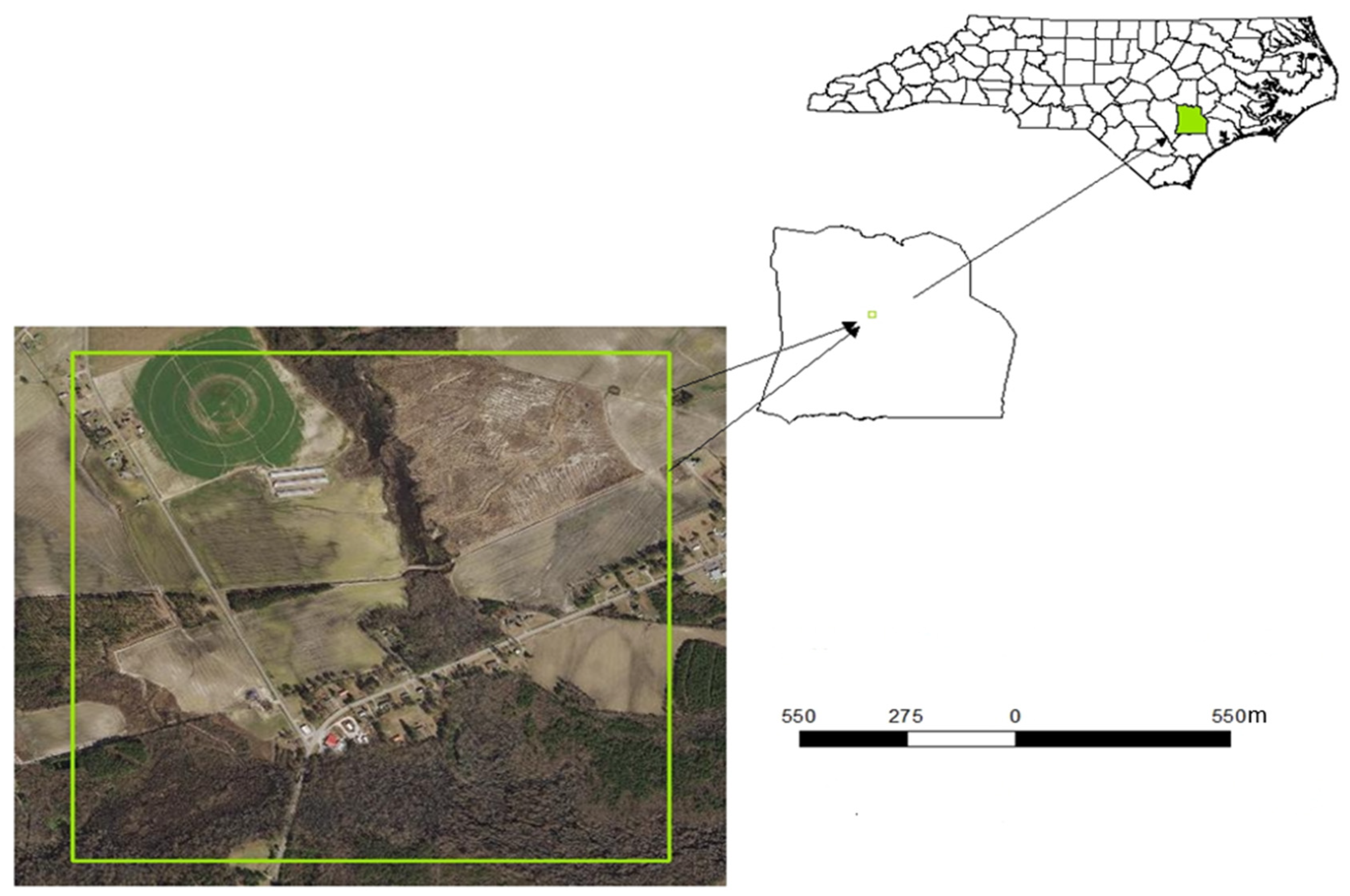

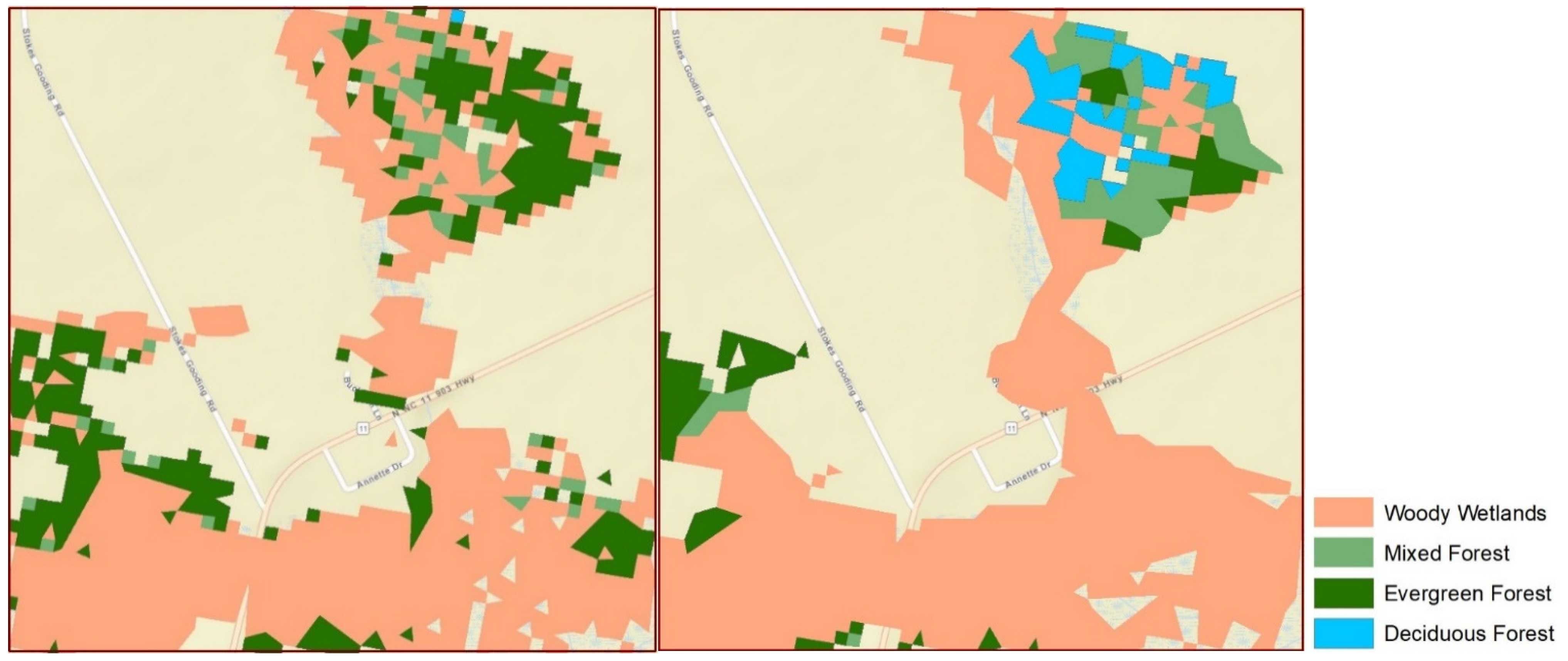
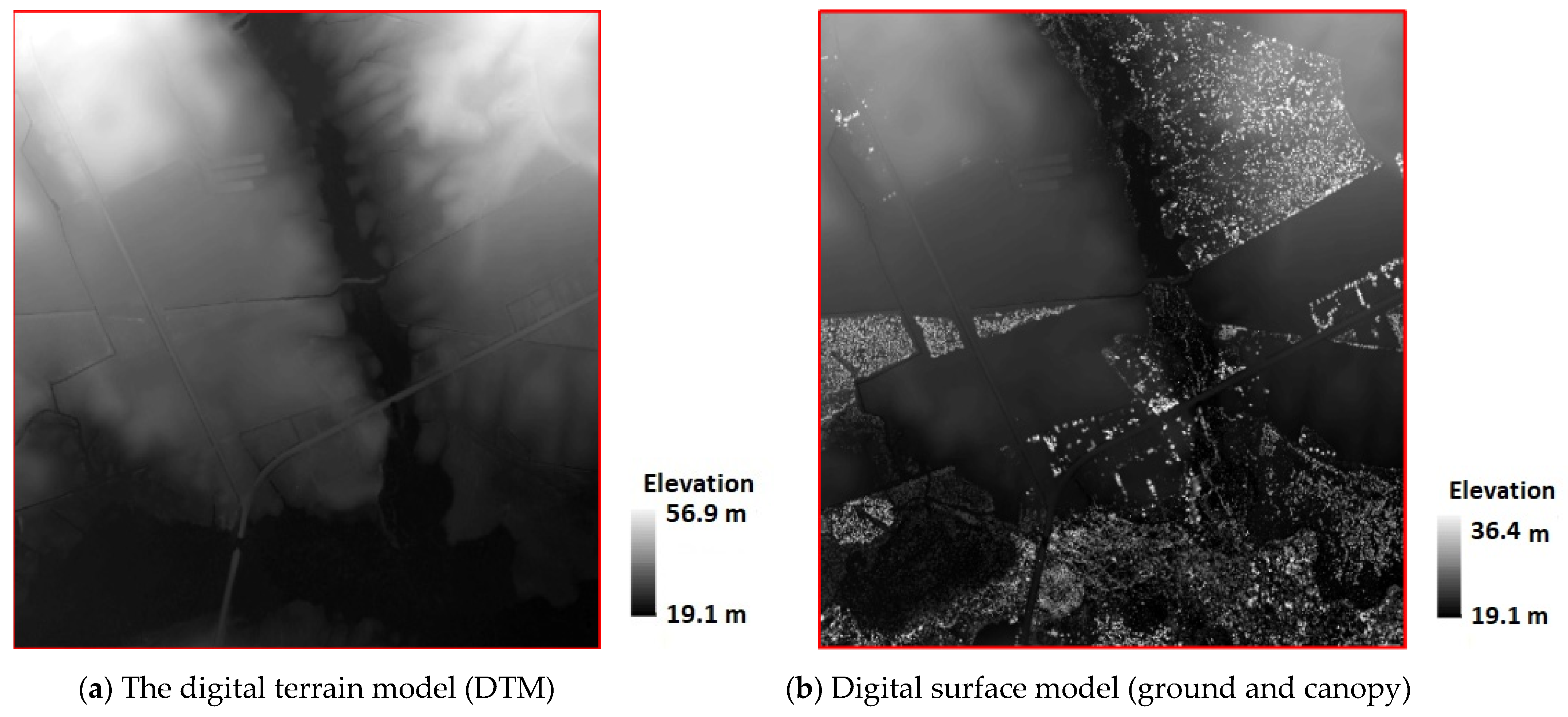
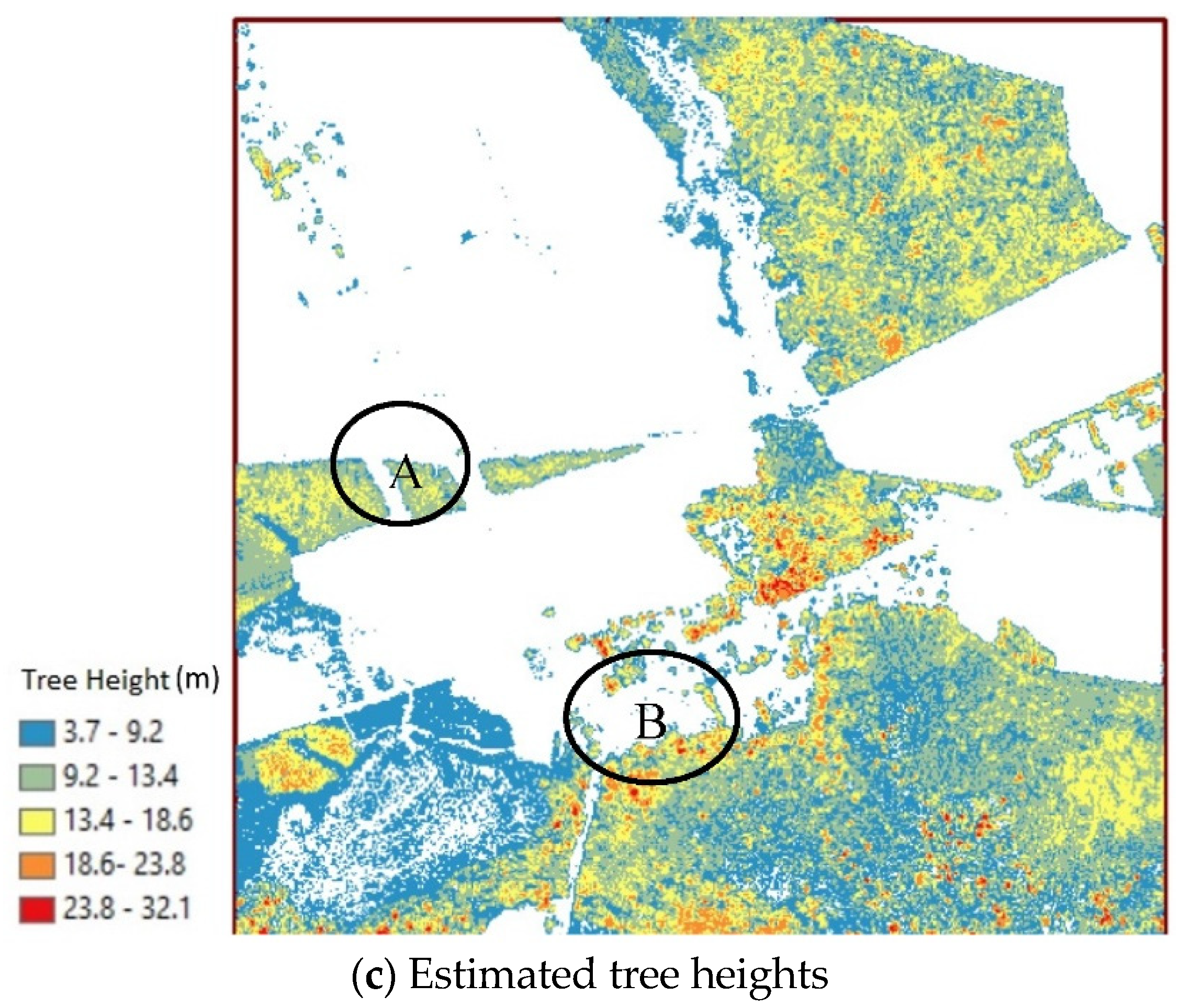
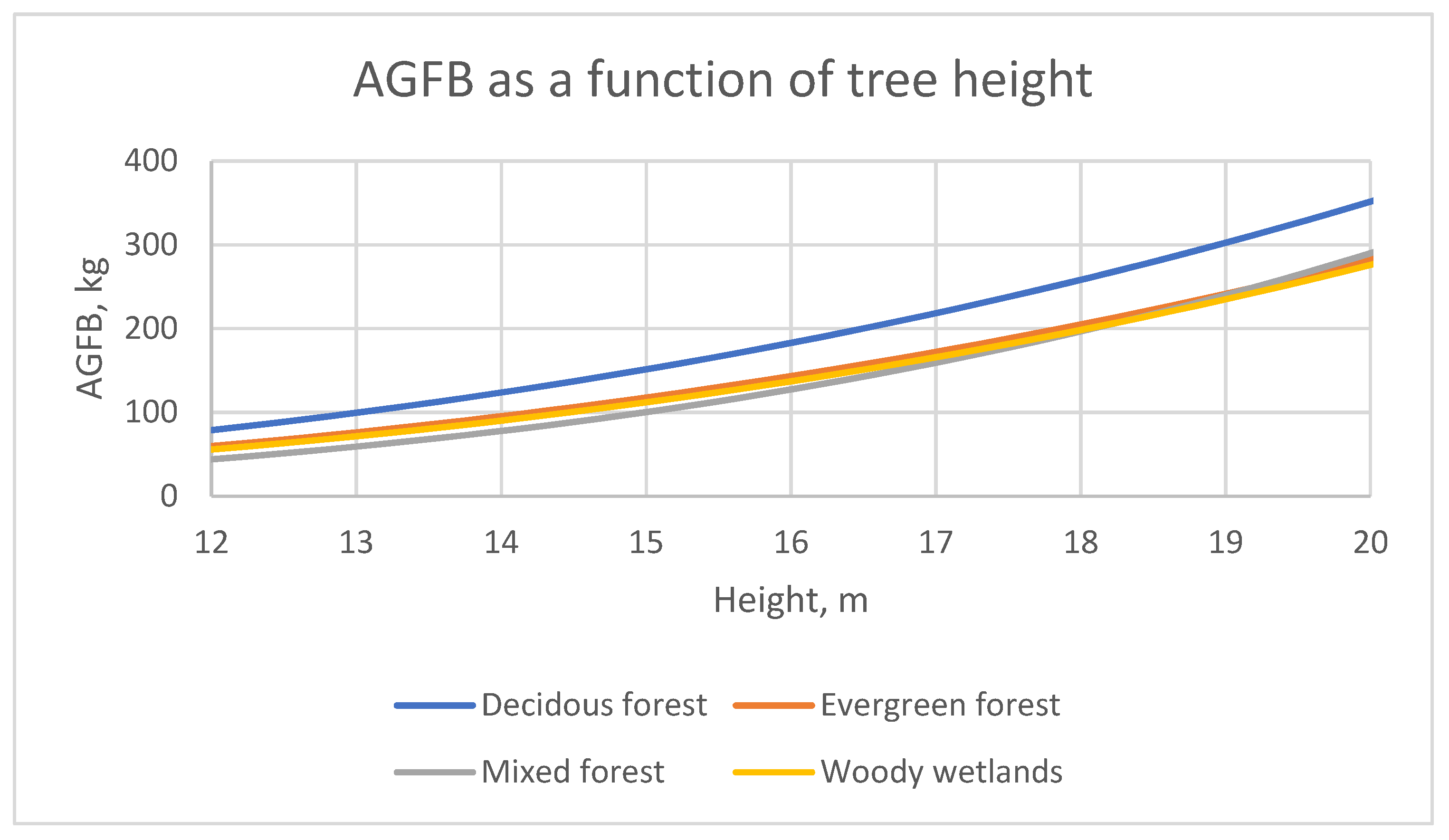
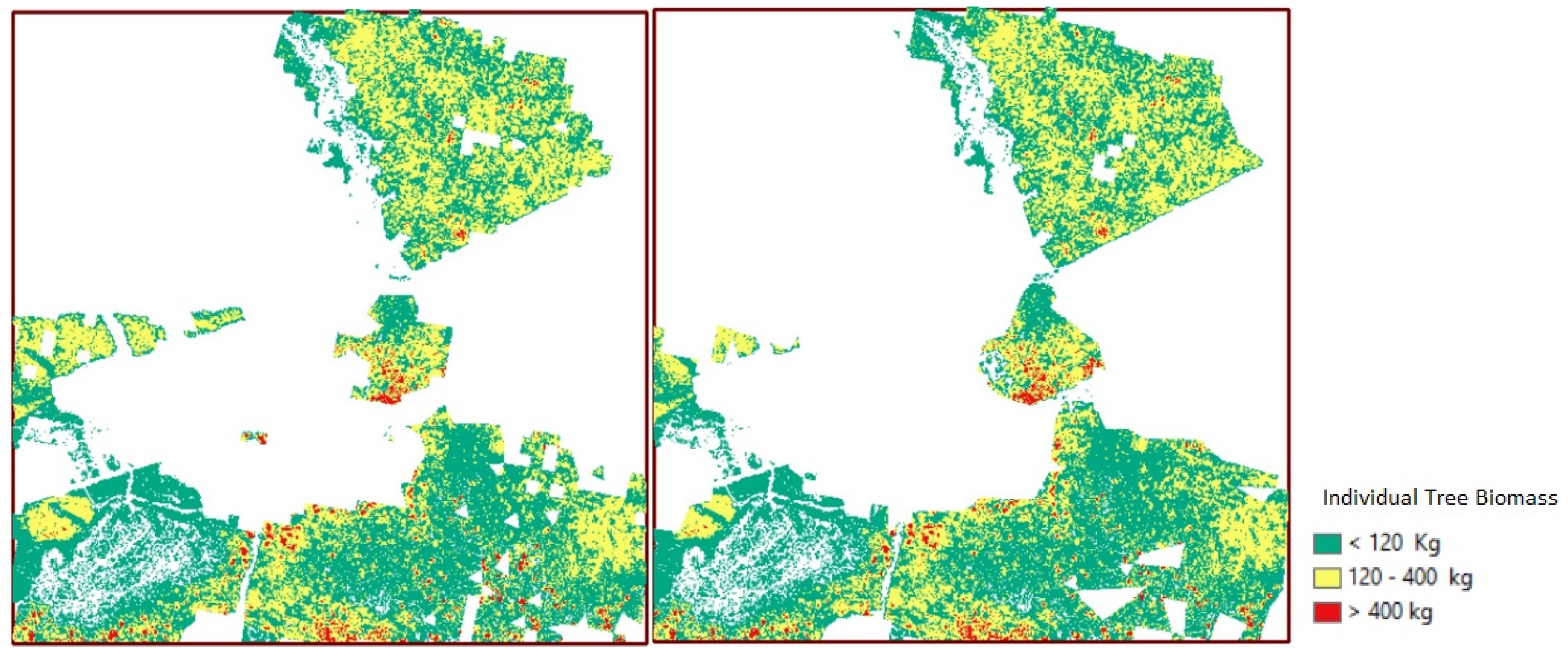
| Land Cover | CDL | NLCD | Area Difference between CDL and NLCD, % 3 | ||
|---|---|---|---|---|---|
| Code(s) 1 | Hectares | Code(s) 2 | Hectares | ||
| Water | 92, 111 | 765 | 11 | 766 | 0% |
| Developed land | 121, 122, 123, 124 | 8894 | 21, 22, 23, 24 | 9472 | −6% |
| Barren land | 131 | 60 | 31 | 702 | −169% |
| Shrubland | 152 | 28,567 | 52 | 27,274 | 5% |
| Grassland, hay and pasture | 37, 176 | 18,602 | 71, 81 | 8875 | 71% |
| Cultivated crops | Multiple 4 | 56,517 | 82 | 75,728 | −29% |
| Herbacious wetlands | 195 | 703 | 95 | 3890 | −139% |
| Total for land cover other than forest | 114,108 | 126,707 | −10% | ||
| Deciduous Forest | 141 | 179 | 41 | 329 | −59% |
| Evergreen Forest | 142 | 45,838 | 42 | 32,182 | 35% |
| Mixed Forest | 143 | 2933 | 43 | 7061 | −83% |
| Woody Wetlands | 190 | 48,583 | 90 | 46,157 | 5% |
| Total for forested land | 97,533 | 85,729 | 13% | ||
| CDL | Total | |||||||||
|---|---|---|---|---|---|---|---|---|---|---|
| Deciduous Forest | Evergreen Forest | Mixed Forest | Woody Wetlands | Shrubland | Herbaceous Wetlands | Cultivated Crops | Other | |||
| NLCD | Deciduous Forest | 0 | 15 | 15 | 39 | 3 | 0 | 0 | 0 | 72 |
| Evergreen Forest | 0 | 73 | 3 | 13 | 5 | 0 | 1 | 0 | 95 | |
| Mixed Forest | 0 | 39 | 13 | 31 | 7 | 0 | 1 | 1 | 92 | |
| Woody Wetlands | 0 | 119 | 27 | 629 | 73 | 9 | 3 | 3 | 863 | |
| Shrubland | 1 | 12 | 1 | 34 | 58 | 0 | 8 | 8 | 122 | |
| Herbaceous Wetlands | 0 | 13 | 1 | 18 | 12 | 0 | 35 | 0 | 79 | |
| Cultivated Crops | 0 | 4 | 2 | 10 | 58 | 0 | 820 | 67 | 961 | |
| Other | 0 | 1 | 0 | 28 | 7 | 7 | 127 | 124 | 294 | |
| Total | 1 | 276 | 62 | 802 | 223 | 16 | 995 | 203 | 2578 | |
| FIA Forest Type | CDL/NLCD Forest Type Assigned | Tree Count ** | ||
|---|---|---|---|---|
| Code and Name * | Description of Typical Sites * | Hydric Site? ** Yes or No | ||
| 161—Loblolly pine | Sites—upland soils with abundant moisture but good drainage, and on poorly drained depressions. | No | Evergreen | 848 |
| Yes | Woody wetlands | 15 | ||
| 166—Pond pine | Sites—rare, but found in southern New Jersey, Delaware, and Maryland in low, poorly drained acres, swamps, and marshes. | Yes | Woody wetlands | 89 |
| 406—Loblolly pine/hardwood | Sites—usually moist to very moist though not wet all year, but also on drier sites. | No | Mixed | 161 |
| 508—Sweetgum/yellow-poplar | Sites—generally occupies moist, lower slopes. | No | Woody wetlands | 41 |
| Yes | Woody wetlands | 29 | ||
| 519—Red maple/oak | Sites—uplands. | No | Deciduous | 77 |
| 608—Sweetbay/swamp tupelo/red maple | Sites—very moist but seldom wet all year shallow ponds, muck swamps, along smaller creeks in Coastal Plain. | No | Woody wetlands | 254 |
| Yes | Woody wetlands | 94 | ||
| 708—Red maple/lowland | Site—generally restricted to very moist to wet sites with poorly drained soils, and on swamp borders. | No | Woody wetlands | 23 |
| Total observations | 1631 | |||
| Variable, Units of Measurement | Statistic | NLCD/CDL Forest Type, Number of Observations | |||
|---|---|---|---|---|---|
| Deciduous Forest, 77 obs. | Evergreen Forest, 848 obs. | Mixed Forest, 161 obs. | Woody Wetlands, 545 obs. | ||
| DBH, cm | Mean | 16.3 | 16.9 | 15.1 | 18.3 |
| Median | 15.7 | 16.5 | 14.0 | 16.0 | |
| Minimum | 2.8 | 2.5 | 2.5 | 2.5 | |
| Maximum | 62.5 | 47.8 | 55.1 | 72.1 | |
| Standard deviation | 9.0 | 8.1 | 11.8 | 12.3 | |
| H, m | Mean | 12.8 | 12.5 | 11.9 | 14.1 |
| Median | 14.3 | 12.8 | 11.0 | 13.4 | |
| Minimum | 4.0 | 3.4 | 3.4 | 2.1 | |
| Maximum | 21.6 | 25.9 | 35.1 | 37.5 | |
| Standard deviation | 4.3 | 4.9 | 6.2 | 6.5 | |
| Variable | NLCD/CDL Forest Type, Number of Observations | |||
| Deciduous Forest, 77 obs. | Evergreen Forest, 848 obs. | Mixed Forest, 161 obs. | Woody Wetlands, 545 obs. | |
| Constant, α | −0.421 (0.176) | −0.380 (0.065) | −1.168 (0.126) | −0.522 (0.073) |
| Height, β | 1.238 (0.070) | 1.248 (0.026) | 1.515 (0.052) | 1.263 (0.028) |
| R2 | 0.81 | 0.73 | 0.84 | 0.78 |
| Forest Type | γ | δ | Burrill et al. (2017) Species [15] | Jenkins (2003) Species Group [51] |
|---|---|---|---|---|
| Deciduous | −1.9123 | 2.3651 | Red oak, maple | Soft maple/birch |
| Evergreen | −2.5356 | 2.4349 | Loblolly pine, pond pine | Pine |
| Mixed | −2.5356 | 2.4349 | Loblolly pine | Pine |
| Woody wetlands | −2.48 | 2.4835 | Sweetbay, swamp tupelo | Mixed hardwood |
| Forest Type | CDL | NLCD | ||||
|---|---|---|---|---|---|---|
| Total Area (ha) | Avg. Tree Height (m) | Total B (kg) | Total Area (ha) | Avg. Tree Height (m) | Total B (kg) | |
| Decidious | 0.1 | 15.24 | 15,880 | 6.5 | 16.6 | 3,977,151 |
| Evergreen | 24.8 | 16.68 | 10,882,703 | 8.5 | 16.53 | 3,192,142 |
| Mixed | 5.6 | 14.13 | 1,083,462 | 8.3 | 15.21 | 2,238,870 |
| Woody Wetland | 72.2 | 16.91 | 31,776,530 | 77.7 | 18.32 | 45,428,628 |
| Total | 102.7 | 101 | 54,836,791 | |||
Publisher’s Note: MDPI stays neutral with regard to jurisdictional claims in published maps and institutional affiliations. |
© 2021 by the authors. Licensee MDPI, Basel, Switzerland. This article is an open access article distributed under the terms and conditions of the Creative Commons Attribution (CC BY) license (https://creativecommons.org/licenses/by/4.0/).
Share and Cite
Hashemi-Beni, L.; Kurkalova, L.A.; Mulrooney, T.J.; Azubike, C.S. Combining Multiple Geospatial Data for Estimating Aboveground Biomass in North Carolina Forests. Remote Sens. 2021, 13, 2731. https://doi.org/10.3390/rs13142731
Hashemi-Beni L, Kurkalova LA, Mulrooney TJ, Azubike CS. Combining Multiple Geospatial Data for Estimating Aboveground Biomass in North Carolina Forests. Remote Sensing. 2021; 13(14):2731. https://doi.org/10.3390/rs13142731
Chicago/Turabian StyleHashemi-Beni, Leila, Lyubov A. Kurkalova, Timothy J. Mulrooney, and Chinazor S. Azubike. 2021. "Combining Multiple Geospatial Data for Estimating Aboveground Biomass in North Carolina Forests" Remote Sensing 13, no. 14: 2731. https://doi.org/10.3390/rs13142731
APA StyleHashemi-Beni, L., Kurkalova, L. A., Mulrooney, T. J., & Azubike, C. S. (2021). Combining Multiple Geospatial Data for Estimating Aboveground Biomass in North Carolina Forests. Remote Sensing, 13(14), 2731. https://doi.org/10.3390/rs13142731








